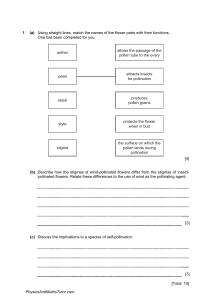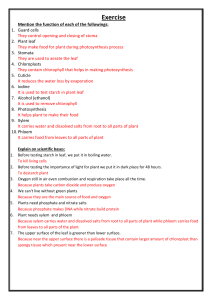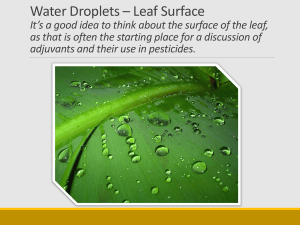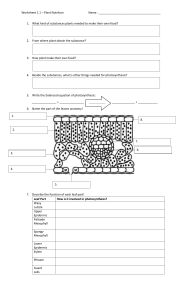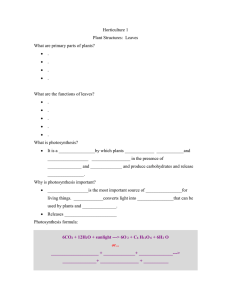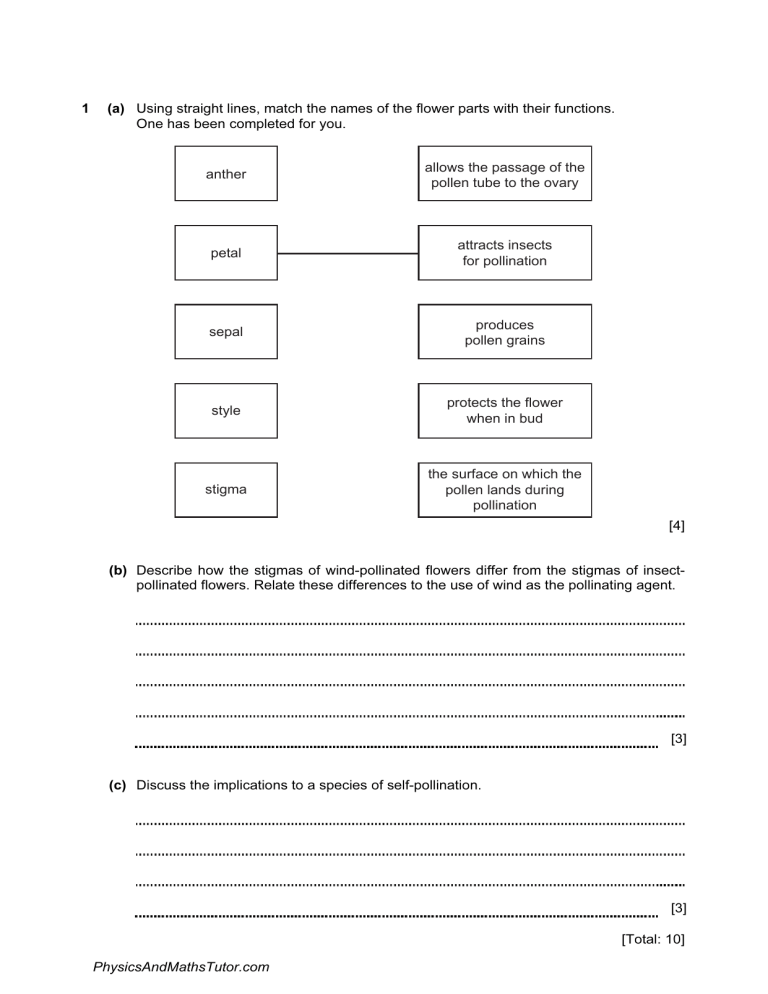
1 (a) Using straight lines, match the names of the flower parts with their functions. One has been completed for you. anther allows the passage of the pollen tube to the ovary petal attracts insects for pollination sepal produces pollen grains style protects the flower when in bud stigma the surface on which the pollen lands during pollination [4] (b) Describe how the stigmas of wind-pollinated flowers differ from the stigmas of insectpollinated flowers. Relate these differences to the use of wind as the pollinating agent. [3] (c) Discuss the implications to a species of self-pollination. [3] [Total: 10] PhysicsAndMathsTutor.com 2 Fig. 2.1 shows crop productivity for a range of plants but the bar graph is incomplete. 9.0 world average 8.0 highest highes 7.0 6.0 productivity per day of growing season / g per m2 5.0 4.0 3.0 2.0 1.0 0 wheat oats maize rice type of crop Fig. 2.1 PhysicsAndMathsTutor.com potatoes sugar beet (a) Complete Fig. 2.1 using the following data. crop productivity per day of growing season / g per m 2 world average potatoes ota highest yield 5.6 [2] (b) State which crop has (i) the highest average productivity, (ii) the greatest difference between the average yield and the highest yield. [2] (c) Outline how modern technology could be used to increase the productivity of a crop from the average yield to a high yield. [3] (d) When the yield is measured, dry mass is always used rather than fresh mass. Suggest why dry mass is a more reliable measurement than fresh mass. [1] PhysicsAndMathsTutor.com (e) Maize is often used to feed cows, which are grown to provide meat for humans. Explain why it is more efficient for humans to eat maize rather than meat from cows that have been fed on maize. [3] (f) (i) Complete the equation for photosynthesis. light energy 6CO2 + 6H2O C6H12O6 + ................. [1] (ii) Describe how leaves are adapted to trap light. [2] (iii) With reference to water potential, explain how water is absorbed by roots. [3] (iv) Explain how photosynthesising cells obtain carbon dioxide. [2] [Total: 19] PhysicsAndMathsTutor.com 3 An experiment was carried out to find out if carbon dioxide is needed for photosynthesis. Stage 1. Two plants, A and B, of the same size and species were kept in a dark place for 48 hours. Stage 2. A leaf from each plant was then tested for the presence of starch using iodine solution, to show that destarching was complete. Stage 3. Both plants were placed in sealed glass containers, for 24 hours, as shown in Fig. 5.1. Plant A was in the presence of potassium hydroxide beads (which absorb carbon dioxide). Plant B was in the presence of glass beads. All other conditions needed for photosynthesis were provided for both plants. Stage 4. After 24 hours a leaf from each plant was tested for the presence of starch. glass cover plant potassium hydroxide (to remove carbon dioxide) glass beads plant A plant B Fig. 5.1 PhysicsAndMathsTutor.com (a) (i) The stages involved in testing a leaf for starch are shown below. The stages are in the correct sequence, but the reasons are in the wrong order. Use straight lines to match the stages with the correct reasons. One has been done for you. stage reason boil the leaf in water ethanol (alcohol) is flammable turn off any naked flames to test for starch boil the leaf in ethanol (alcohol) to break down cell membranes soak the leaf in water to remove chlorophyll add iodine solution to the leaf to soften the leaf [4] (ii) Explain why chlorophyll is removed from the leaf before testing it for starch. [1] (b) State two factors, other than carbon dioxide, that both plants would need in order to photosynthesise. 1. 2. [2] (c) Plant B was used as a control in the experiment. Explain the importance of this control. [1] (d) Explain why the plants were destarched. [1] PhysicsAndMathsTutor.com (e) Complete the table. Use ticks and crosses to show if the starch test for plants A and B would be positive () or negative () at stage 2 and stage 4. In each case, explain your answer. stage leaf from plant 2 A and B starch test ( or ) explanation A 4 B [3] (f) In a further experiment, another destarched plant was kept in the dark. The concentration of carbon dioxide in the container was measured at regular intervals and was found to increase with time. Explain why the concentration of carbon dioxide increased. [3] [Total: 15] PhysicsAndMathsTutor.com 4 (a A typical dicotyledonous leaf contains a number of different types of cells, including: guard cells, palisade mesophyll, spongy mesophyll and upper epidermal cells. Using the types of cells listed above, complete the table by (i) writing the types of cells in the order that sunlight passes through them, (ii) stating the proportion of chloroplasts in each of the types of cells. Use the terms none, some and many. type of cell number of chloroplasts [3] Stomatal pores are surrounded by pairs of guard cells. When the stomata are closed the rate of photosynthesis is affected, due to a limiting factor. (b) (i) Write a balanced equation, using chemical symbols, for the process of photosynthesis. [2] (ii) Define the term limiting factor. [2] (iii) State the factor that limits photosynthesis when the stomata are closed. [1] PhysicsAndMathsTutor.com (c) Vascular bundles, containing xylem and phloem tissue, are situated in the leaf. (i) Describe the structure of xylem tissue. [3] (ii) State the functions of xylem and phloem. Function of xylem Function of phloem [4] (d) Some plants close their stomata during the hottest part of the day, despite the effect on photosynthesis. Suggest what benefit this might be to the plants. [1] [Total: 16] PhysicsAndMathsTutor.com

